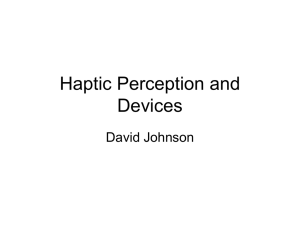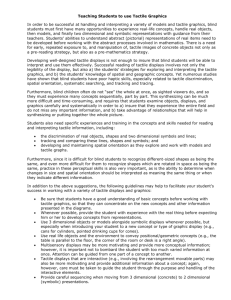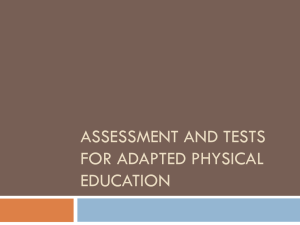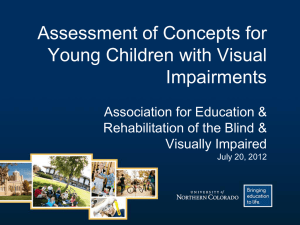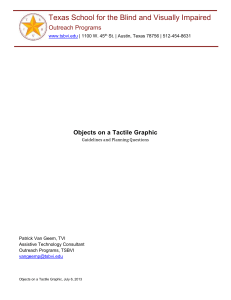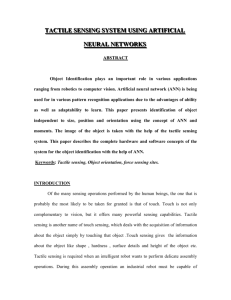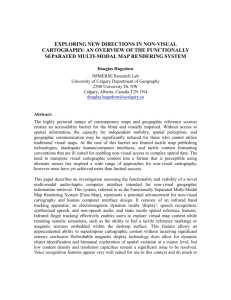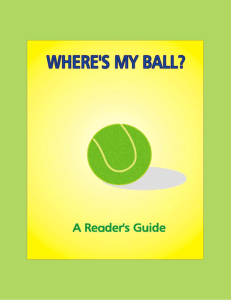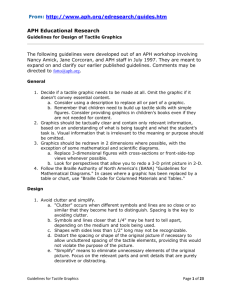If you Love Me, read me a braille story
advertisement
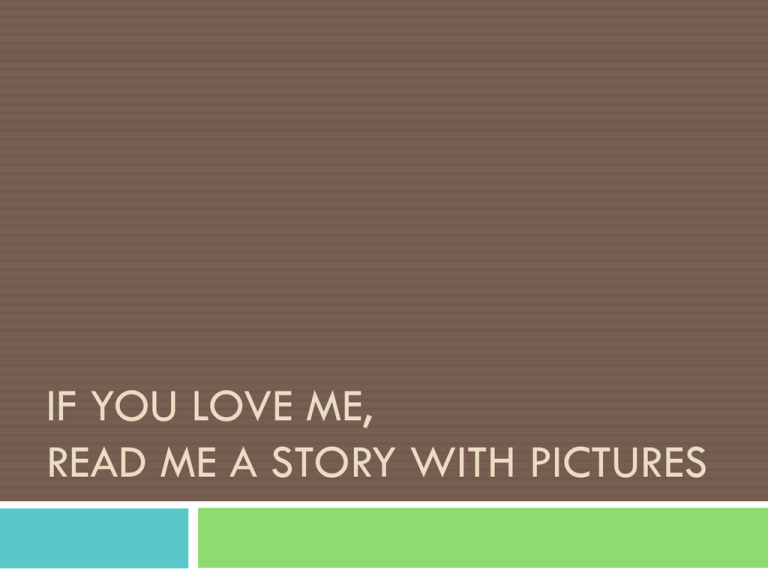
IF YOU LOVE ME, READ ME A STORY WITH PICTURES http://farm1.static.flickr.com/52/136206296_3c34d00263.jpg Examples of novelty books for sighted children So close… and yet so far away http://mainlineparent.com/2010/10/for-the-love-of-especially-good-childrens-books/ Is this book accessible? terra.com Here’s an example of one of the best tactile books in the world, handmade by Lynette Rudman from South Africa. This book won first place in the international Typhlo and Tactus tactile illustrated books competition held in France in 2009. http://www.tactilegraphics.co.za/ …another book designed by Lynette Rudman. This was a top contender in the Typhlo & Tactus competition in 2011. http://www.tactilegraphics.co.za/ Early experience is key A review of the literature shows... The capacity of congenitally blind adults for mental imagery and spatial competence is closely correlated with early levels of experience and expertise with tactile drawings (Dulin & Hatwell, 2006) When readers who are blind are introduced to tactile graphics early in life, many visual two-dimensional representations of three-dimensional objects are as accessible to them as they are to sighted readers (Kennedy & Fox, 1977) Early tactual exposure to form and figure helps develop a young child's readiness for reading with the fingers (Harley, Truan & Sanford, 1997) Graphicacy is an extension of literacy The literature also shows... Graphics facilitate cognitive processing and retention (Lewalter, 2003; Sung & Mayer, 2012) Early and consistent exposure to graphics prepares students to become proficient tactile graphic users in middle and high school (Zebehazy & Wilton, 2014) Tactile illustrations can help motivate children to want to learn to read (Ripley & Voutilainen, 2007) Role of tactile illustrations… To be effective, a tactile illustration should provide the child with a tactual experience that, along with the book’s words, triggers a connection with the child’s own experience of the object in everyday life. (Wright & Stratton, 2007) Principles of good tactile design… Use distinctly different textures, shapes, lines, and symbols Simplify Avoid clutter Avoid many intersecting lines Use fill patterns or textures If the illustration has many elements, break it into two or more separate illustrations Principles of good tactile design… Individual pieces should not overlap. Front views of the body are preferred with side views of animals (in their entirety). Shapes represented must be sufficiently thick (at least 1mm). There must be a proportionate relationship between the pieces. Initially, images should be two dimensional. Best practices… Begin with real objects for the youngest students. Allow the child to develop in his ability to interpret tactile images. Start simple and increase complexity as skills increase. Give assistance for interpreting each graphic. Use a variety of materials. Making it meaningful… Even with good tactile design, illustrations still may not trigger an association with the real objects or concepts the child knows. Begin with the child. Consider previous experiences, background knowledge and abilities. Consider the story or text. Whether you add tactile illustrations to a published children’s book or illustrate a book that you or the child has written, carefully consider the most central aspects of the text. After identifying the central objects and concepts in the story, decide what type of tactile illustration will best depict these (objects, textures, cut-out shapes and textures, raised and filled outlines, unfilled outlines). Challenges and Limitations… The purpose of a tactile illustration is to communicate an idea or information – not to reproduce a visual picture in a tactile form A tactile illustration can never be as complete as a visual picture or understood as instantly and completely http://www.aph.org/dolly-partons-imagination-library/suggestions.html Include the child… One of the surest ways to create a tactile illustration that has meaning for a child is to involve the child in choosing how to illustrate a particular thing or concept Aldrich & Sheppard (2001) found that younger students in particular enjoy the process of creating their own tactile graphics Creating tactile books with children... Ideas Texture book Pipe cleaner book Counting book Alphabet book Gooey book Cutting book Point book Fastener book Staple book Experience book Book about me Shape book Book of curves Concept book Books with braille labels and simple tactile graphics of familiar objects Another award-winning book “There is a wonder in reading Braille that the sighted will never know: to touch words and have them touch you back.” ~ Jim Fiebig http://www.aph.org/dolly-partons-imagination-library/suggestions.html http://www.ehow.co.uk/how_2104756_buy-childrens-books-braille.html APH Guide Telling Stories Through Touch Typhlo & Tactus Guide e-Handouts… If a picture’s worth a thousand words... If a picture’s worth a thousand words... how much is a touch worth? References… Dulin, D., & Hatwell, Y. (2006). The effects of visual experience and training in raised-line materials on the mental spatial imagery of blind persons. Journal of Visual Impairment & Blindness, 100, 414– 424. Harley, R. K., Truan, M. B., & Sanford, L. D. (1997). Communication skills for visually impaired learners. Springfield, IL: Charles C. Thomas Publisher, LTD. Kennedy, J. M., & Fox, N. (1977). Pictures to see and pictures to touch. In D. Perkins & B. Leondar (Eds.), The arts and cognition (pp. 118–135). Baltimore, MD: Johns Hopkins University Press. Lewalter, D. D. (2003). Cognitive strategies for learning from static and dynamic visuals. Learning & Instruction, 13(2), 177–189. doi:10.1016/S0959 – 4752(02)00019-1 Ripley, M. & Voutilainen, P. (2007). Typhlo and Tactus: The European organization of tactile book producers. Focus on International Library and Information Work. 38(3). Retrieved from http://www.cilip.org.uk/get-involved/special-interestgroups/international/publications/Documents/focus3832007.pdf Sheppard, L., & Aldrich, F. K. (2001). Tactile graphics in school education: Perspectives from teachers. British Journal of Visual Impairment, 19, 93–97. doi: 10.1177/ 026461960101900303 Sung, E., & Mayer, R. E. (2012). When graphics improve liking but not learning from online lessons. Computers in Human Behavior, 28(5), 1618–1625. doi:10.1016/ j.chb.2012.03.026 Zebehazy, K. T., & Wilton, A. P. (2014). Charting success: The experience of teachers of students with visual impairments in promoting graphic use by students. Journal of Visual Impairment & Blindness, 108(4), 263–274.
